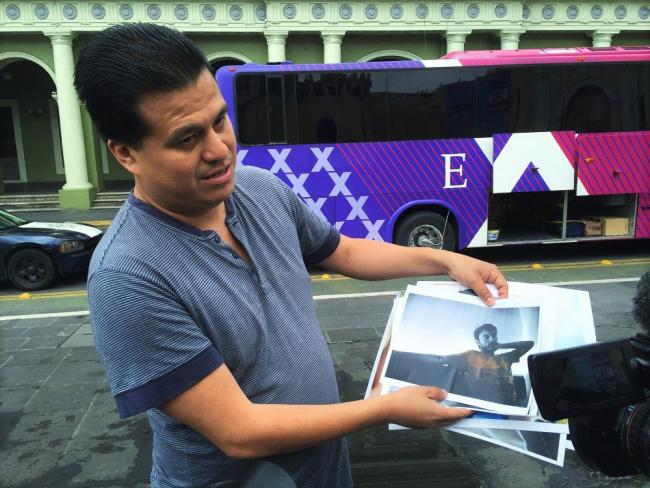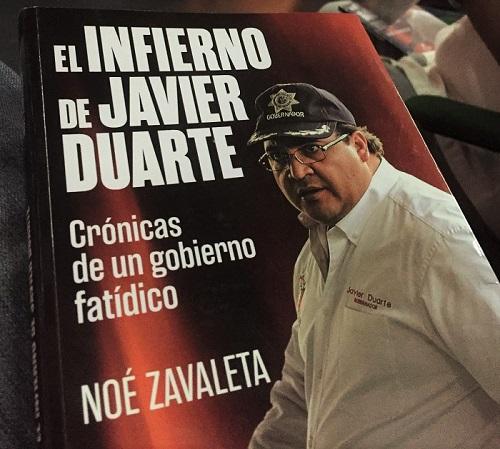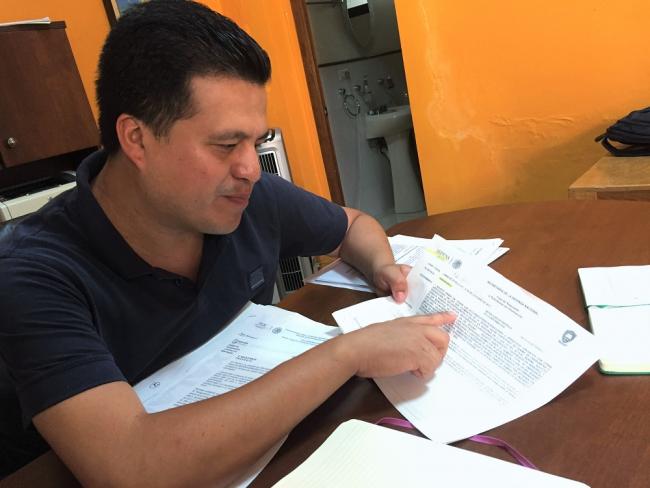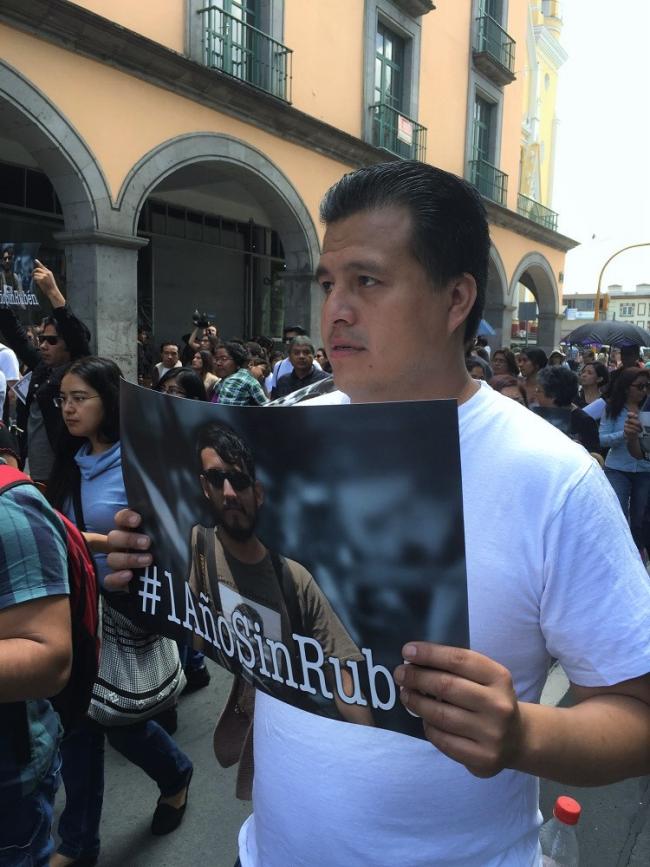
Noé Zavaleta is a brave Mexican journalist. He works—or used to work—in Veracruz. In the last six years, seventeen journalists have been murdered and five have gone missing in the mountainous coastal state that rings a sizable chunk of the Gulf of Mexico, according to Articulo 19. Its eight million inhabitants have access to at least 66 newspapers in print, with many more online sources, television, and radio. But the risks faced by its news gatherers mark Veracruz as notorious: It is the most dangerous place in the Americas to work as a journalist. It’s this risk that has forced Zavaleta to take a break from reporting from Veracruz. The risks he faces recently worsened.
At 35, the broad-smiled Zavaleta is jovial, even jocular, though he’s a veteran of reporting from a de facto warzone. The war between organized criminal groups has quickened of late, particularly in the state’s south and center. The Zetas—formed in the 1990s out of deserters from the Mexican Army’s special forces—are no longer dominant but are still powerful, dueling with their adversaries, the Matazetas (Zeta killers), also known as the Cartel Jalisco Nueva Generación (CJNG), who are rumored to be backed by the Veracruz government’s own security forces. The body count indicates a dreadful dynamic: from 2015 to 2016, homicides in Veracruz increased 120 percent, from 219 homicides to 537 homicides. In July 2016, the count stood at 132 homicides, making it the state’s bloodiest month since 1997.
Zavaleta is spooked by recent threats made against him for his first book, Javier Duarte’s Hell (published in Spanish as El Infierno de Javier Duarte), published in June 2016. Duarte, 43, is the controversial, scandal-plagued governor of Veracruz, Mexico’s third largest state. In his book, Zavaleta paints a graphic picture of what corruption, impunity and government incompetence have looked like between 2010 and 2016, the sexenio (or six years) of Duarte’s government. His term ends on November 30, 2016.

Duarte has never been able to—or has chosen not to—gain control over the state’s public security crisis. Veracruz’s long coastline and strategic hold over transportation links to Mexico City, the U.S.-Mexico border and ports along the Gulf Coast make it a prize for both human and drug smugglers. Violence is particularly acute around the southern oil city of Coatzacoalcos and in the mountainous central region of Orizaba. But other places are also affected, too: in the port of Veracruz, there have been shootouts in June and July; in the northern coastal access city of Poza Rica, a journalist was shot outside her home, perhaps in a failed robbery; and, in the state capital of Xalapa, a group of armed men kidnapped two women from the same family from their home, beheaded them, and then dumped their bodies and heads in different locations.
The surge in homicides in Veracruz accounts, in part, for the uptick in Mexico’s overall homicide numbers. The murder rate worsened in 2015 and is on pace to worsen again in 2016. In 2014, Mexico’s national murder rate was 16.71 per 100,000 inhabitants. In 2015, the murder rate is 16.96 per 100,000. In 2015, there were 17,028 homicides in Mexico. Neither the state government in Veracruz nor the national government in Mexico—both from the same party, the Partido de la Revolución Institucional (PRI)—have succeeded in reducing homicides. At the hands of Governor Duarte in Veracruz, spending on public safety more than doubled during the past six years of his administration, from $120 million USD to $250 million USD. But the only thing to show for it is a worsening public security crisis.
Noé Zavaleta has a comb of thick, gelled-back black hair, a thatch atop a handsome, rectangular face. He’s angered some important people in Veracruz for his investigative reporting, but he’s pleased many more with diligent investigations about Duarte’s disastrous time in office. Audiences packed presentations about the book throughout Veracruz in August. But he is spooked—the book’s publication has brought threats against his life—and instead of walking through Veracruz unaccompanied while he reports, he now has bodyguards. He’s also taken the precaution of taking a break from reporting in the state; now he reports about Veracruz from Mexico City. Having to seek refuge in Mexico City is not an ideal situation for a provincial journalist, but Zavaleta wants to keep himself safe and, as the Duarte administration reaches its end, the risks against journalists reporting on its various crises—from public security to the financial scandal surrounding Duarte—have increased.
Zavaleta was born in Xalapa, Mexico, in 1981. He graduated from the Universidad Veracruzana in Communications in 2003, doing a stint after graduation at Sur, a newspaper in Boca del Río now called Imagen del Golfo, the shiny, suburban city connected to the down-at-heel Port of Veracruz. Eventually Zavaleta began to write for Blog.Expediente.com under the instruction of Luis Velázquez, a retired journalism professor with an eye for astute political analysis and biting satire.
It’s not well known that Velásquez has almost single-handedly trained a younger generation of critical, investigative reporters in Veracruz. Zavaleta’s articles at the blog soon became indispensable reading for journalist Marcela Turati. Currently a Neiman Fellow at Harvard University for her reporting in Mexico over the last 20 years, Turati turned to Zavaleta’s writing to find out what was going on at the beginning of Duarte’s term as governor of Veracruz. “Frequently my searches always led to stories by Noé Zavaleta,” she said on August 10 at the Mexico City launch of Javier Duarte’s Hell. Turati recommended him to colleagues at Proceso in 2012; he’s been submitting regular reporting about Veracruz ever since.
Zavaleta has never shied from documenting the disaster roiling his native state, a place he says where under Duarte’s rule “hell established a franchise.” Yet the dangers are obvious: Proceso has suffered the murders of two of its Veracruz reporters, Regina Martínez in April 2012 and Rubén Espinosa on July 31 2015, shot to death along with four other civilians in a Mexico City apartment. In fact, it was Martínez’s murder that prompted Turati’s recommendation to Proceso. “When Proceso hired me in 2012, I wasn’t Regina Martínez’s replacement,” he told me. He started at Proceso to cover her murder, and stayed on to cover politics and corruption, public safety, and governmental incompetence.
But it’s also fair to say that, in Veracruz, journalists did not just report the news, they became news, too: a significant part of Zavaleta’s book recounts violence against journalists. He pays the most attention to his Proceso colleagues, Martínez and Espinosa. First he joined the staff to report on the investigation into Martínez’s murder, staying on as Veracruz correspondent based in Xalapa. Soon he befriended photojournalist Rubén Espinosa. They worked steadily together in Xalapa and throughout Veracruz until Espinosa’s murder in Mexico City in July 2015.
Sitting in his office at the Crónica de Xalapa, a news website that Zavaleta directs— like most Mexican journalists he has to support himself by working more than one job— the Xalapeño native tells me about why he wrote his book, how he works as a journalist in Veracruz, and what the limits are to reporting when journalists are murdered with impunity. He explained why he keeps on working, notwithstanding the many journalists murdered in the state during the Duarte years.
“I keep working for two reasons. One reason sounds kind of dumb. What else am I going to do? Drive a taxi? Sell mobile phones? Grab my camera and go to churches for weddings and quinceañeras? Reporting is what I know how to do. I don’t know how to do anything else. I don’t know if I do it well. The many—or the few depending on what people want to see—readers I have must decide that.”
“It’s also a bit of civil resistance, too. You come across so much pain in the streets. I mean, imagine if I let my resolve to report cave in. I’ve seen mothers of the disappeared spend more than a thousand days looking for their missing children. Every day they wake up wondering if their child has eaten and if they are going to eat breakfast that day. There are even women who have become activists after they have had to bury their children.” Zavaleta dedicated his book to these women, and to Espinosa, his murdered colleague and friend.
Javier Duarte’s Hell is timely. It’s the first book to chronicle the events of Duarte’s six years in power—twenty stories in plain prose about “corruption, impunity, and government negligence,” he tells me. “It’s a book about the place where there have been 950 disappearances during this sexenio. It’s brutal. Most of them are young people, between 17 and 27.”
He tells me what he has to do to get those figures, a statistical topography of pain and suffering that Duarte’s state government refuses to acknowledge. “I got the numbers on disappearances through transparency laws,” says Zavaleta. “You have heard of InfoMex? I request data through transparencia,” he says, referring to the freedom of information portals of all Mexican government websites. “Then I have to go through review procedures and submit request after request.” From his desk in Xalapa he pulls out a stack of near-to-hand papers associated with freedom of information act requests, the top sheaf from the Defense Ministry detailing its anti-narcotic activities in Veracruz, number of square meters of marijuana burned, poppy destroyed, the statistics of the drug war.

Even for Zavaleta, the book is not quite the in-depth reporting he would like. “In Veracruz, you have to scratch around where you can and up to the limits of where you can, too. It’s not that I don’t want to investigate, it’s that, as in my case, there are limits to where you can get to.”
Turati’s prologue to the book captures the dilemma of the working Veracruz journalist: Veracruz “is a place where the air is toxic for journalists. Those who can flee do so. Statistics do not count those displaced and exiled.”
The University of San Diego’s Freedom Expression Project at its Trans-Border Institute estimates that at least 25 journalists have fled Veracruz since 2011. Indeed, after the recent threats, Zavaleta added himself to their number, deciding to flee the state. He’s not alone. Last year prize-winning photojournalist Felix Márquez decided to pursue opportunities in Chile, immediately after Espinosa’s murder. And Márquez, like Zavaleta, refuses to say he has gone into exile. “Taking a break is more like it,” Zavaleta wrote me in late August.
The depressing facts of being a working journalist in Veracruz do not deter Zavaleta from continuing to report. Tall, energetic and demonstrative, Zavaleta speaks as he writes. He’s quick-paced and eloquent at book presentations in Mexico City and Xalapa, always using a story to illuminate a point. His writing draws upon clearly defining characters that allow him to describe corruption, organized crime, and governmental negligence. Zavaleta’s articles stand out in Proceso, Mexico’s oldest and most prestigious investigative journalism magazine. Espinosa’s photographs often heightened his articles’ reception. In fact, it’s an Espinosa photo on the book’s front cover.
Zavaleta’s persistence with transparency requests pays off. Duarte’s government has consistently sought to downplay the public security crisis, but the facts, after Zavaleta uncovers them, are inescapable. Mexico’s Attorney General (Procuradaría General de la República, PGR) provided Zavaleta with statistics on forced disappearances since 2012, during the current term of President Enrique Peña Nieto. Unlike disappearances “por particulares” (by individuals associated with organized crime), forced disappearances refer to an incident in which somebody disappears and there are signs of authorities’ involvement. He shows me papers from the Attorney General. “With 183 people forcibly disappeared, Veracruz accounts for seventeen percent of forced disappearances. Tamaulipas is second with 173 forced disappearances, or sixteen percent since 2012, then comes Guerrero.”
One of the obstacles to reporting in Veracruz is the state government’s attempt to minimize this violence. In October 2014 at the World Trade Center in Boca del Río, Governor Duarte said where once people talked about shootouts and murders in Veracruz, now they talk about convenience store robberies of Frutsis and Pinguinos, a type of drink and cupcake . Duarte has never lived down the comments. Given official concern with the state’s image, Zavaleta seems slightly anxious by the Duarte government’s feeble response to his book. “They haven’t said anything, absolutely nothing,” he told me. “In the past they have attacked me on social media, and from fake email addresses, trying to undermine my professional work with outrageous stories about my personal life. That I arrange orgies, that I’m a drug addict, that I’m bisexual, that I’m gay, or that I’m effeminate. In anonymous emails I’m accused of having affairs with my married female friends. With the book’s publication I was expecting something from the government, but nothing,” he said. “It leaves me a little unsettled.”
It wasn’t long after we met in Xalapa at the end of July before Zavaleta began to receive threats provoked by the book’s revelations. The threats reveal the cost of not staying silent, particularly about ties between government and business. José Abella, a businessman and owner of the newspaper El Buen Tono from Córdoba, about three hours south of Xalapa, physically threatened Zavaleta for exposing subsidies his newspaper received from Duarte’s state government. Governor Duarte grew up in Córdoba. The Governor and Abella are pictured in photographs together, smiling. Zavaleta responded to Abella with documents that proved El Buen Tono was one of the state government’s creditors. At presentations about the book, Zavaleta tells audiences, “I spent about two lines in the book mentioning Abella.” Even so, threats followed, and people started watching his house.
“I wasn’t taking Abella’s threats very seriously on Friday, but on Saturday when he accused me of working with the Zetas, that’s when I really started to get worried,” he said on August 10, 2016 at the launch of his book in Mexico City. As the Cartel Jalisco Nueva Generación, the rivals of the Zetas, currently dominate Veracruz, the association could be lethal for Zavaleta. “I will not permit such allegations,” said Zavaleta to audiences in Mexico City and Xalapa.
Neither did Proceso. The magazine assigned Zavaleta two bodyguards, a couple of middle-aged burly men with inquisitive eyes who traveled with the reporter between Veracruz and in Mexico City. Zavaleta spent hours filing complaints against Abella in state and federal jurisdictions because of the threats. His complaint to the Federal Prosecutor for Crimes Against Freedom of Expression (FEADLE – La Fiscalía Especial para la Atención de Delitos cometidos contra de la Libertad de Expresión) required traveling at least four and a half hours from Xalapa to Mexico City, followed by another four hours of interviews. And even then the procedure wasn’t over. Zavaleta’s complaint would also require a follow-up psychological exam, “just to make sure I’m not paranoid. It’s a big distraction from the work of reporting,” he told me as we left the FEADLE offices in downtown Mexico City. At book presentations the bodyguards have stayed within close range.
Nightclub singer and Veracruz native Paquita la del Barrio once sang, “Veracruz is a little piece of the Republic that knows how to suffer and sing.” In other words, despite tremendous suffering in the state, the people keep on with their business, like reporting the news. Zavaleta’s book is filled with stories of suffering but also of survival, persistence, and resilience. His own story— from within the body count of dead journalist colleagues—reflects these traits.
After the 2015 murder of his coworker and friend Rubén Espinosa, “I had two options,” Zavaleta said. “One, hide my head under the covers to cry, asking for a transfer to the sports section, or political or environmental reporting. Maybe tourism, I don’t know. Or face what’s going on saying, ‘Here we are and I was here. Ya basta! We’ve had it up to here.’ I have a vocation and there’s a cause.”
Zavaleta’s book narrates the impunity for murders of journalists in Duarte’s Veracruz. Proceso has not been the only news outlet in the state that has lost one or more of its reporters. Daily newspaper Notiver in the Port of Veracruz is also on that unfortunate list.
Days before beginning a slew of presentations about his book, Zavaleta stands with dozens of other journalists from Veracruz and Mexico City to commemorate one year since the murder of Proceso’s Espinosa. Nothing has happened in the case. “The authorities don’t want to do anything, nor will they do anything,” said Zavaleta.
Zavaleta knew Espinosa for more than five years and worked with him on stories for Proceso for at least three. In February 2014, the magazine published his and Espinosa’s first cover story, an article about the ongoing security crisis in Veracruz. Espinosa’s cover photo now defines much of the murdered photojournalist’s work. He unflatteringly captured the governor as a grimacing, portly state policeman wearing a baseball cap. Zavaleta devoted two chapters to telling Espinosa’s story.
Zavaleta sees the book as a way to remember Espinosa’s work. “Every part of the profession has learned to grieve for its dead. I, for example, can talk to you about Rubén. But then there’s the last journalist murdered just a few weeks ago, Pedro Tamayo. My colleague Ignacio Carvajal is a reporter in Coatzacoalcos and he grieves for Pedro because they were both friends and had reported on mass graves together. Here in Xalapa, the crime beat reporters mourn Victor Baez (murdered in 2012). In the Port of Veracruz the photojournalists grieve over El Mariachi, Gabriel Hugé (also murdered in 2012); the Notiver journalists miss Milo Vela (Miguel Ángel López Velasco, murdered with his wife and son, Misael in 2011). Still other journalists in the Port miss Misael, who was also a photojournalist.” Zavaleta’s point is unmistakable: in Veracruz every journalist mourns a dead journalist.

“One of the things we have realized as journalists in Veracruz is that we are all vulnerable, we are all fragile. If they want to kill you, they are going to kill you. I don’t want to tempt fate but I always ask ‘Who’s next?’ The body count just has not stopped. So, you have to ask, who’s next? It’s provocative, cruel, and it might be rude but you have to ask, ‘Who’s next?’”
“I don’t want to be the next number,” says Zavaleta to me and to audiences at presentations of his book in Mexico City and Xalapa. “I don’t want to be the number after that, either. I don’t want to be any number at all.”
Patrick Timmons lectures in History at El Paso Community College. He received his PhD from the University of Texas at Austin in 2004. Since 2011 he has offered human rights accompaniment to journalists in Mexico.

